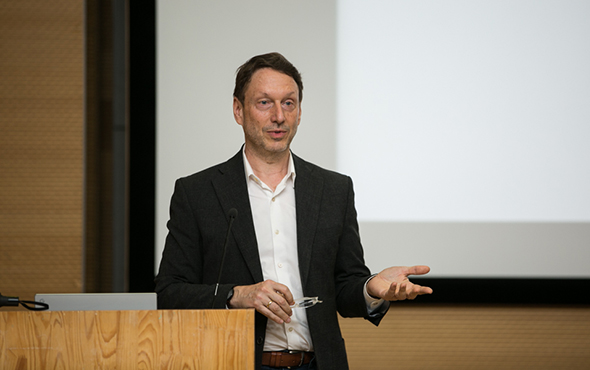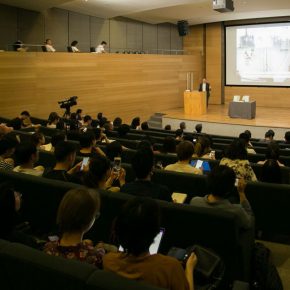
At 6:30 PM, June 19th, 2018, a lecture by James Elkins, sponsored by the School of Humanities of CAFA and Jiangsu Fine Arts Publishing House was held in the lecture hall of the Art Museum of CAFA. The lecture coincided with the launch of his new book first translated into Chinese – Visual Culture Theory Series: The Domain of Images. Professor James Elkins is the director of the art history, theory, and criticism at the School of the Art Institute of Chicago, and the Chair of the Department of Art History at University College Cork in Ireland. In the lecture, Elkins analyzed the changing trend of art from rationality toward emotions from the perspective of visual culture, as well as the key factors of the transition from the postmodernism art to contemporary art in relation to other various factors.
The lecture was divided into five sections: inward thinking, immersion, empathy, affected theory, and beauty. Within each section, Elkins introduces the semiotic meaning of each term, elucidated from them with corresponding research results in the related field combined with his own understanding, and then exemplified them in a larger context. He first gave his research point: if the post-modernism art is defined as rationalism – lacking of emotional color – could there be any changes within contemporary art?
“Introspection” was the first keyword in the lecture, which originally in German means “feelings of the thought”. Elkins began his talk with a psychological portrait of Rembrandt. Traditional artists are good at depicting characters or body gestures as a way to express rich emotions, but later, this method was abandoned by later artists. He listed some rationalism works, which are mainly portraits and sculptures, such as Max Beckmann's Self-Portraits, the face images in Jaume Plensa's Crown Fountain in Chicago, and Auerbach's EOW Nude. These works which intentionally do not show facial expressions and dynamics of the characters, prevent the viewers from appreciating the feelings of them. It is a popular approach for artists to present the work, called anti-psychographic art technique. However, according to Elkins, expressionlessness is also a sort of expression; moreover, it can reflect the inner state of the character better and his/ her introspection. For example, in a performance work by Marina Abramovic, Seated 4 Minutes, the artist sat quietly for 4 minutes in the front of the viewer who could also feel the emotional fluctuations in her.
Elkins interpreted “immersive” as “completely involving and forgetting oneself”, that is, the viewer forgot that they were at an exhibition while viewing the works. Some contemporary artists also used the immersive experience of the viewers as the purpose of their artworks. Elkins also referred to "theatricality" – a term used by Michael Fried. He further explained that Fried did not favor minimalist art because of its incapability of creating an immersive moment for the viewer. Then, Elkins exemplified the term “immersive” with its theatrical effect, such as the immersive experience of interactive games, the VR device in the museums, and the reflection of the film “The World of Truman”, as well as made some suggestions on how to get this kind of “immersive experience”, such as without looking at label descriptions in an exhibition and to try and look at a work for more than an hour.
When explaining “empathy,” Elkins cited German philosophers Robert Vischer and Theodor Lipps’s understanding of this term, which they regard as an uncontrolled human behavior. For example, when people are looking at tall objects, the body will probably unconsciously shake, as certified scientifically. Also, when we see the works of Kandinsky, the color block in the painting may unconsciously be moving and bring an association of ideas. This is called “empathy”; for example, when people play a piano key, other keys will also quiver with it. As a trend, contemporary artists are trying to achieve this effect of empathizing with viewers.
“Affect theory”, closely related to the first three keywords in the lecture, also has been widely discussed in academia; Elkins referred to the theoretical and illustrative explanations in Massumi’s book — Parables of the Virtual. He mentioned that the emotions in the “emotion theory” are powerful, impulsive and subconscious. He discussed Meltzer’s concepts in his book Beyond the Aesthetic and the Anti-Aesthetic, thereby deepening the understanding of “Effect theory." Elkins also quoted Jaak Panksepp, a neuroscientist, on the results of research on the stress response of foxes as an illustration of the potential expansion in the field of emotional research. At this point, the topic of contemporary art shifted from the cold and rational art to a discussion of hot and sensuous art that stimulates human emotions. This is evidenced in the theoretical circles as well as in the artistic practice.
In the last section, Elkins discussed the return of “beauty” by analyzing Dave Hickey's Air Guitar, Arthur Danto’s The Abuse of Beauty, and other scholars. In addition to aesthetics, he also mentioned it in a religious field which was very inspiring for the audience. Professor Elkins posited some new highlights beyond the traditional research methods which made teachers and students attending the lecture more interested in this field. Everyone was very enthusiastic about the question-and-answer session, and Elkins responded to the questions, such as the factors causing a turn in the trend of art, the definition of postmodernism, and the term “theatricality” by Michael Fried. The lecture was very successful and everyone listened carefully till the final word was spoken.
Text by Wang Yutong, translated by Yue Yao and edited by Sue/CAFA ART INFO
Photo and Video by Hu Sichen/CAFA ART INFO





































